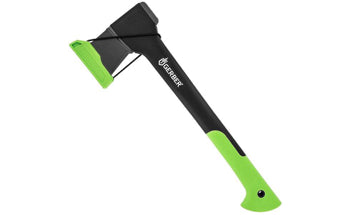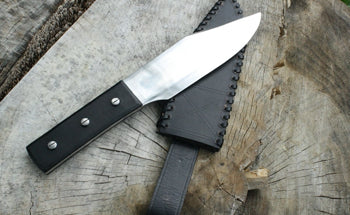Here's a Little Video to Get You Pumped to Read This Article
How to Throw Large Double Bit Axes

Axes have been around for millennia. It is the perfect multipurpose tool. It can be used to fell a tree, split a log, hammer a nail, skin an animal, and even chop vegetables and meat for dinner. It has been used in both war and peace. It’s big, heavy, and sharp. It can also be a whole lot of fun.
Up until the invention of modern warfare and reliance on firearms, axes were often used as projectile weapons—along with spears, javelins and rocks—on the battlefield. As a group of warriors charged an opposing force, they would hurl small battleaxes at the enemy. This was meant to injure and confuse the enemy prior to engaging in hand-to-hand combat. The axe is a particularly effective projectile. Even if it does not strike blade first and inflict a mortal wound, it is still a heavy object thrown at a high rate of speed. If it hits something, it is going to inflict damage.
Today, no one uses the throwing axe in warfare, but many people enjoy throwing axes as a hobby. You have probably seen lumberjack competitions broadcast on some of the major sports networks. Watching professional lumberjacks hurl those massive double-bit axes across distances of thirty feet or more into a large block of wood is certainly impressive. These men train for years to fine tune their technique and increase their accuracy, but you can learn how to throw an axe in the matter of a few afternoons. You likely won’t be as good as the professionals, but you can get an axe to consistently “stick” in the target. Once you can throw an axe, who needs darts?
What You Will Need:
- A Double Bit Axe—We recommend that you use one of the many throwing axes on the market and found on this site. They are specifically designed to be thrown, but in reality, any axe can make a serviceable projectile. If you are anxious to get started, you really just need a standard axe.
- A Target—The best targets are made from thick tree trunks cut into rounds. They are heavy, stable, and they can take a beating. Ideally, you would use several of these rounds to construct a pyramid target, but a single round mounted on 2 sawhorses or other stable base with a 2X4 as a stabilizing brace will suffice. Just make sure your target is about chest height.
- A Can of Spray Paint—Eventually, you will get tired of just making the axe stick in the block. You will want to begin aiming. Go ahead and paint a nice red bull’s eye right in the center of your target block.
- A Clear Throwing Area- You will need an area of at least 30 feet by 15 feet in which to practice. You don’t want anything behind the target that could potentially be damaged by an errant throw. You definitely do not want to park your car or lawnmower back there.
Steps to Throw Your Axe
At its core, throwing axe technique involves 2 things—distance and rotation. Distance is important because when you throw the axe it will rotate. You must be the proper distance from the target to ensure that it hits blade first. Rotation is also important and is tied directly to distance. As a beginner, you want your axe to make one full rotation as it covers the distance from you to the target. Under or over rotating will cause the axe to bounce off the target or not strike true.
Finding the Correct Distance
Handle length dictates the distance you should be from the target. The longer the handle, the longer it will take the axe to make a full rotation. When using a double bit axe with approximately a 29-inch handle, you want to be at least twenty feet away from your target (about 7 paces). There is an easy way to determine if you are at the proper distance from the target. When the axe sticks, if the handle is pointing to the target, you are too close. If the handle of the axe is pointing to you, you are too far back. If the handle is parallel to the target, you are dead on.
Finding Your Stance
You want a stable base when throwing a larger axe. You should place your dominant foot (right foot for right-handed people, left foot for left-handed people) on your mark. Your other foot should be about half a step behind your lead foot. Keep your knees slightly bent for stability. If you feel out of balance, don’t hesitate to widen or narrow your stance. Make sure your hips and shoulders are aligned with the target.
Holding Your Axe
When throwing a larger axe, it is best to use the double grip, overhand throw. Some experienced throwers, who have built up the muscles in their forearms, can throw a large axe with a single-hand throw, but for beginners, it’s easier to use both hands. Grip the axe low on the handle in a baseball style grip with your dominant hand on top.
Finding the Target
When throwing an axe, focusing on the target is the most important aspect of accuracy. You should focus your eyes on your intended target and black out everything else. If you do this, your body will automatically make the minor adjustments needed to strike the target.
Throwing Your Axe
Hold your axe in front of you perpendicular to the ground. Smoothly bring it over your head as you transfer your weight to your back foot. As you bring the axe forward, transfer your weight back to your lead foot. Release the axe as your forearms reach the parallel plane with the ground. Make sure to keep your wrist locked to aid rotation and prevent injury. There is no need to throw hard or move fast. A smooth delivery is all you need. The weight of the axe will do all the work.
Adjusting Your Distance
Once you hear that solid THUNK! and catch the throwing bug, you may even want to purchase and experiment with other types of throwing axes such as competition axes, hatchets, and tomahawks. You will be happy to know that the principle you learned here apply across all axes. Focus on distance—usually about 5 paces for a standard 17-19 inch competition axe-- rotation, and smooth delivery and you can easily stick any axe. Even if you switch to a single-handed grip, the motion will stay the same. Transfer weight to the back foot as you bring the axe back, to the front as you push it forward, and release when your forearm is parallel to the ground. Remember to keep your wrist locked.
Throwing Other Axes
Watch how the axe strikes the target. Are you too close or far away? Make minor adjustments to your distance from the target and repeat your throw until you are hitting the target every time and the handle is always parallel with the target.
Conclusion
Throwing axes are a blast, and it does not take long to become hooked. Just remember to always temper your enthusiasm with caution. Always throw your axes in a safe manner. These are large, heavy, sharp objects and bad things can happen if you become careless. Always watch out for others, and never attempt to throw an axe after consuming alcohol. Alcohol and sharp projectiles are a bad mix. Happy throwing!




















